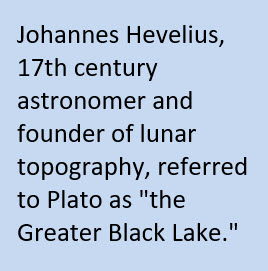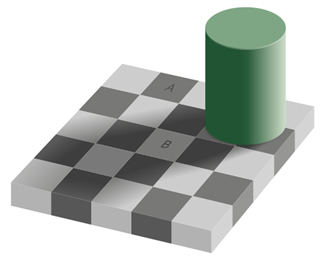The week of November 20-26 takes us from Day 8 to Full Moon. This week we will highlight the moon crater Plato, viewable on Tuesday evening and located in the NW quadrant of the Field Map at D9.
 Plato: [NW/D9; L=9°W] Wait until the terminator is a little to the west of Plato (toward the end of Day 7 or beginning of Day 8, depending on libration) and you will witness one of the Moon’s loveliest sights. At such a time, the early morning Sun will be filtering through the mountain peaks and casting long spire-like shadows on Plato’s floor. Within a short time it will look like the skyline of an entire city has been outlined on the interior plains of Plato. The process begins quite magically as small areas on Plato’s floor start to glow eerily. If you’re not prepared for it, you’ll be mystified by what is happening, but within a short time the outline of the eastern rim peaks will take shape and become apparent. If you’re lucky enough to catch this process at the beginning, come back every 15 minutes or so to watch the scene unfold.
Plato: [NW/D9; L=9°W] Wait until the terminator is a little to the west of Plato (toward the end of Day 7 or beginning of Day 8, depending on libration) and you will witness one of the Moon’s loveliest sights. At such a time, the early morning Sun will be filtering through the mountain peaks and casting long spire-like shadows on Plato’s floor. Within a short time it will look like the skyline of an entire city has been outlined on the interior plains of Plato. The process begins quite magically as small areas on Plato’s floor start to glow eerily. If you’re not prepared for it, you’ll be mystified by what is happening, but within a short time the outline of the eastern rim peaks will take shape and become apparent. If you’re lucky enough to catch this process at the beginning, come back every 15 minutes or so to watch the scene unfold.
There are a few instances where moon craters are seemingly complex, such as Plato and Archimedes (Day 7), but they are lacking the requisite central peaks. So what happened? The peaks are still there; they are actually 1.2 miles high, but they’ve been entirely buried by torrential lava flows! Plato’s original floor is actually 1½ miles deeper than it appears here.
 There is a curious thing that happens to Plato as the Sun rises: the dark-chocolate floor appears to get even darker! This is an illusion. Photometric measurements have proven that the floor actually gets lighter, but it’s hard to convince yourself of that. Come back over the next few nights and see what you think.
There is a curious thing that happens to Plato as the Sun rises: the dark-chocolate floor appears to get even darker! This is an illusion. Photometric measurements have proven that the floor actually gets lighter, but it’s hard to convince yourself of that. Come back over the next few nights and see what you think.
Plato’s floor also presents us with an interesting challenge: There are several tiny craterlets that will test your instrument, your powers of observation, and the atmospheric seeing. There have occasionally been unofficial contests to detect the largest number of craters on Plato’s floor. Although some amateurs have reported dozens, these reports may be specious. As a rule, consider yourself lucky if you can see four. Then come back and try to improve on that number1.
At one point in Plato’s early history there was a dramatic shift of terrain when a large triangular massif, eight miles long, partially disconnected itself from the western rim and started to slide toward the floor. You can see this detached chunk even with small telescopes. And if you look around the rim a short distance to the north, you’ll see there was a similar event.
OF ADDITIONAL INTEREST IN SPACE
On Sunday, Uranus will be 3° south of the Moon.
Plato: (424-348 BCE) Greek philosopher who was a student of Socrates and the teacher of Aristotle. Plato believed that the human senses could not reliably grasp reality, as exemplified most famously in his parable of the cave where a group of prisoners are chained with their backs to a cave entrance. The only thing they can see is the play of shadows thrown against the wall from outside the cave. Because they have never actually seen the real figures that are casting the shadows, they believe that the shadows themselves are the only reality. Plato believes that humanity is no better off than the prisoners: what we firmly believe to be reality has no more substance than the shadows on the walls. It would require a truly extraordinary human being to break free of the chains and make his way into the light of understanding. Alas, when such a person returns to report his findings to the others, he will be met only with disbelief and scorn.
 It may be difficult for modern-day thinkers to accept Plato’s belief that the senses cannot be trusted–after all, seeing is believing, right? But consider this example of how easily we can be convinced that a shadow image is absolute truth. Take a look at the photo to the left. Square B, although it is in a shadow, is obviously lighter than square A, right? Now take a 3×5 card and punch two holes in it so that one hole will fit over square A and the other over square B. Place the holes over the two squares and compare their shades. Then ask yourself if Plato was right–that, indeed, the human senses cannot reliably grasp reality.
It may be difficult for modern-day thinkers to accept Plato’s belief that the senses cannot be trusted–after all, seeing is believing, right? But consider this example of how easily we can be convinced that a shadow image is absolute truth. Take a look at the photo to the left. Square B, although it is in a shadow, is obviously lighter than square A, right? Now take a 3×5 card and punch two holes in it so that one hole will fit over square A and the other over square B. Place the holes over the two squares and compare their shades. Then ask yourself if Plato was right–that, indeed, the human senses cannot reliably grasp reality.
1: The largest of the four is 1.3 miles in diameter, the smallest is 1 mile.
======================
It is highly recommended that you get a copy of Sky and Telescope’s Field Map of the Moon, the very finest Moon map available for use at the telescope. It is available for $10.95 at www.skyandtelescope.com and on Amazon. All features mentioned in this blog will be keyed to the grid on the Field Map and will look like this: Plato: [NW/D9]
Credits:
Courtesy of Gray Photography of Corpus Christi, Texas
Lunar photos: NASA / USGS / BMDO / LROC / ASU / DLR / LOLA / Moon Globe. Used by permission
- Rupes Cauchy: A Best Known Fault on the Moon - July 22, 2024
- Moon Crater Schickard – Crater Floor has Stripes - July 15, 2024
- Moon Craters Langrenus and Vandelinus - July 8, 2024